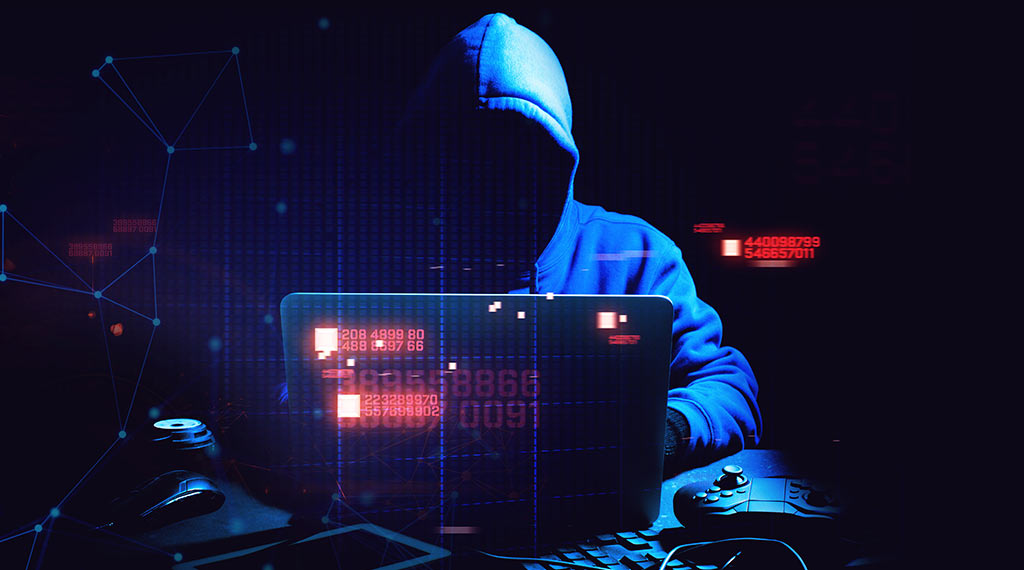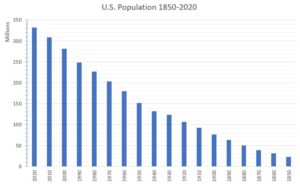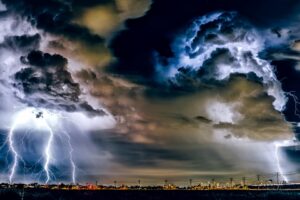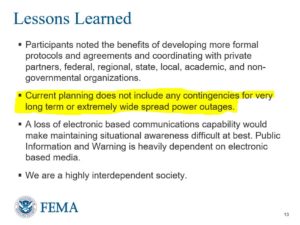Q: How Did We Become So Vulnerable?

A: We became vulnerable gradually. We realized it suddenly.
Papa described it perfectly:
“How did you go bankrupt?” Bill asked.
Ernest Hemingway. The Sun Also Rises. (1926)
“Two ways,” Mike said. “Gradually and then suddenly.”

In 1850 – nine years before the Carrington Event and 12 years before the Civil War – the population of the United States was 23 million people. At the end of 2020, the population of the U.S. stood at 331 million people. What enabled our population to increase by 308 million people? The answer at first would seem complex but it is actually quite simple. Numerous new technologies allowed our population to increase. Advances in medicine, advances in agricultural methods, the ability to transport food across the country (and across the world), new sources and uses of energy, an industrial revolution, advances in many areas of technology… I can go on and on but there is no need to. All of it is tied to one thing: the advent of the electric grid.
In 1850, the country could not have supported a human population of 331 million. We simply did not have technology and resources to support that many people. Our plows were drawn by horse or mule. Much of our population worked hard just to survive the winter – if you didn’t preserve food that you grew and chop wood to keep warm, you simply couldn’t survive. Even in the cities, limitations in technology (e.g., coal mining techniques, transportation, ability to store food) limited the number of people that could be supported by the agriculture and technology of the time.
Gradually, we became vulnerable
The electric grid is an amazing human accomplishment. It is the largest machine in the history of the world, built piece by piece over many generations. It arguably started on September 4, 1882 with Thomas Edison’s Pearl Street Station in Manhattan – which initially had had 82 customers and an electric load of 400 lamps. After “the war of the currents” between Edison’s direct current (“DC”) and George Westinghouse’s alternating current (“AC”), more and more areas began to have electric power available.
So the electric grid that exists today has been built gradually over the last century. The electric grid advanced life in every way imaginable and literally made the impossible possible. The population of the U.S. between 1930 and 2020 increased by over 208 million.

Gradually, we lost the self reliance we had in the 1800s and became completely reliant on all these things that the power grid made possible. New ways to heat (oil, gas, steam electricity, etc.) meant we didn’t have to chop our own wood. Farms were made exponentially more efficient and that meant less of us had to farm.
Better transportation meant that food and goods could be transported long distances. Today, you can get oranges and bananas in New Hampshire – even though they are grown thousands of miles away. This isn’t even a novelty, but something we depend on. We actually get annoyed if there are no bananas in our northern grocery stores.
Gradually, we became dependent on our ability to get food that is produced elsewhere. Most people don’t preserve food for the winter anymore. Gradually, we became dependent on goods such as vehicles and medications that were made possible by electricity. Water and sanitation systems are now completely dependent on electricity – gone are dug wells and outhouses. Our entire financial system has become electronic. You don’t even get paper stock certificates any more – everything is digital.
And then suddenly, we realized that we are vulnerable.
Today, we are literally on life support, plugged into the electric grid. The lives of hundreds of millions of people depend on the things the electric grid provides. Without it, we would literally have what we had in 1850 – except we no longer have the requisite skills and most of us do not own a horse or mule.
Sound far-fetched? Unfortunately it isn’t. In 2017 the U.S. Senate said that the majority of the population of the U.S. would die if the electric grid as successfully attacked – by man or nature! (Read it HERE.) Still not convinced? How about over two decades of federal reports, hearings and Congressional Record detailing the threats to the electric grid? (Read them HERE.) But there must be a plan for this right? Nope. Click on this slide from a FEMA presentation last year. The U.S. has no plan for “very long term or extremely wide spread power outages.”
What getting unplugged looks like
So what happens when a society grows dependent on the electric grid and suddenly, it is unplugged? There are some recent cautionary tales.

In Hurricane Maria, much of Puerto Rico lost power for months. Incredibly, despite the massive assistance and resources the U.S. brought to bear, much of the island was also without potable water for months! The Milken Institute of Public Health estimated the “excess deaths” (i.e., attributable to the aftermath of Hurricane Maria) at 2,975. The New England Journal of Medicine estimated the “excess deaths” at 4,645. We may never know for sure, but it is clear that the loss of power and the problems that accompany a loss of power caused thousands of deaths. (The official death count remained at 64 until August 28, 2018 when the Government of Puerto Rico revised it to 2975 based on the Milken Institute study.)
The March-April 2019 blackouts in Venezuela serve as another disturbing example. Within a short period of time, people had to resort to getting water from the sewage canals, cities experienced anarchy, hospitals had no power or water and food rotted without refrigeration.
For days and nights, unruly crowds sacked 523 stores in Maracaibo as residents stood on their porches wielding weapons to guard against looters. Dozens died in hospitals. Bodies decomposed in the morgue. And what little food remained in refrigerators rotted away as the nation went hungry.
New York Times, March 15, 2019
The United States government and the electric utility industry have for decades failed to address the current threats to the electric grid. For an example of this, look no further than the Texas Blackout of February 2021. In that avoidable tragedy, at least 246 people died according to the State of Texas. The exact same thing happened in Texas in 1989 and 2011 and the problem was never fixed. The industry and regulators just pushed the risk off to the citizens.
To most of us, our experience with power outages is that they last a few hours, or a few days at most. The cavalry is coming. We can bring in utility trucks from Illinois. Somebody will rescue us. We have become complacent.
What if the cavalry is not coming?
There are 35,000 towns and cities in the United States. If substantially all of them are the “disaster area” in a national-scale power outage, where is “help” going to come from? Remember, we have NEVER experienced a national-scale disaster in this country – even Hurricane Katrina and Hurricane Maria were regional in scale and we could bring in massive resources from elsewhere in the country (i.e., from outside the “disaster area”).
If substantially the whole country is the disaster area, your town will be on its own for a long period of time. Perhaps weeks, perhaps months or longer. But today, we are generations removed from adversity, generations removed from self reliance. Generations removed from having to worry about surviving the winter.
We have become extremely vulnerable.
Remember the Americans?
Americans have accomplished great things. We built the transcontinental railroad. We invented airplanes. We landed humans on the moon. We invented much of the industry and technology that exists today. Through sacrifice , grit and determination, our “Greatest Generation” won World War II. We do not have to be helpless. And we can no longer ignore the threats. Remember the Americans? They took action.
As Americans, we need to take action on two things:
- Hold our federal and state governments accountable for protecting the electric grid.
- Prepare our communities for catastrophic disasters by building a culture of preparedness in the U.S.
You can take action. If enough of us take action, we can make a difference. Visit the TAKE ACTION page to see what you can do.
Click To Take Action!
[wpedon id=”5868″ align=”center”]

